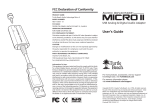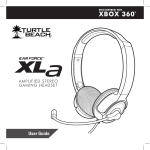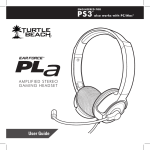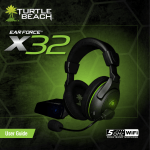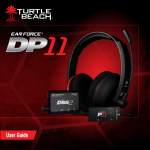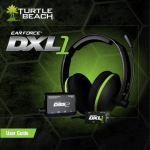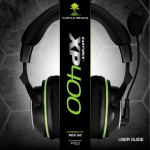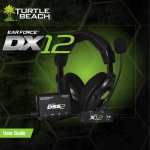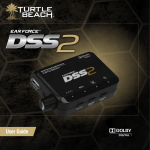Download Turtle Beach Audio Advantage Amigo II
Transcript
FCC Declaration of Conformity PRODUCT NAME: Turtle Beach Audio Advantage Amigo II MODEL NUMBER: TBS-����-�� V� FCC RULES: TESTED TO COMPLY WITH FCC PART ��, CLASS B OPERATING ENVIRONMENT FOR HOME OR OFFICE USE FCC COMPLIANCE STATEMENT: This device complies with part �� of the FCC rules. Operation is subject to the following conditions. (�) This device may not cause harmful interference and (�) This device must accept any interference received including interference that may cause undesired operation. CAUTION: Changes or modifications to this unit not expressly approved by the party responsible for compliance could void the user’s authority to operate the equipment. PARTY RESPONSIBLE FOR PRODUCT COMPLIANCE: Voyetra Turtle Beach, Inc. ��� Clearbrook Road, Suite ���, Elmsford, NY ����� Tel: (���) ���-���� Fax: (���) ���-���� Information To User: This equipment has been tested and found to comply with the limits for a Class B digital device, pursuant to Part �� of FCC rules. These limits are designed to provide reasonable protection against harmful interference in a residential installation. This equipment generates, uses, and can radiate radio frequency energy and, if not installed and used in accordance with the instructions, may cause harmful interference to radio communications. However, there is no guarantee that interference will not occur in a particular installation. If this equipment does cause harmful interference to radio or television reception, which can be determined by turning the equipment off and on, the user is encouraged to try to correct the interference by one or more of the following measures: (�.) Reorient or relocate the receiving antenna. (�.) Increase the separation between the equipment and receiver. (�.) Connect the equipment into an outlet on a circuit different from that to which the receiver is connected. (�.) Consult the dealer or an experienced radio TV technician for help. RoHS COMPLIANT USB Sound Card & Headset Adapter User’s Guide ® For more products, accessories, and our support knowledge base, visit TurtleBeach.com For warranty information please visit www.turtlebeach.com/support Copyright © 2010, Voyetra Turtle Beach, Inc. (VTB). All rights reserved. No part of this document may be reproduced without permission. Turtle Beach, the Turtle Beach logo and Audio Advantage are registered trademarks of VTB. Inc. Windows and Vista are registered trademarks of Microsoft Corporation. Mac is a registered trademark of Apple, Inc. All other trademarks are properties of their respective companies and are hereby acknowledged. Product features, visual design, package contents and specifications are subject to change without notice. Made in China. Product# TBS-1155-01 V1 Setup Instructions To use the Audio Advantage Amigo II with a Windows® PC/laptop or Mac®, simply plug it into a USB socket and the LED on the unit should light up, indicating that it’s powered. The Windows or Mac operating system will automatically detect the device and inform you when it’s ready to use. The �.�mm stereo analog output jack can be used to connect headphones and powered speakers. Once the Amigo II is set up as described below, you can use headphones or speakers by plugging them into the jack. You can connect an external microphone to the Mic Input jack. For instance, if you’re using a headset that has a microphone, you can connect the microphone from the headset to Amigo II’s mic input. If your PC or laptop has more than one USB socket, you should always try to use the same socket for plugging in the Amigo II. This will assure that it will always be recognized as the same device by the operating system. PLEASE NOTE: Some USB hubs may have problems providing a consistent data stream for digital audio and may cause data stream packet loss. This could result in clicks or distortions on the USB audio from the Amigo II. If you experience this problem when the Amigo II is connected to your USB hub, do not use the hub and instead connect the Amigo II directly to the USB port on your Mac or PC/laptop. Using the Amigo II with Windows® XP Using the Amigo II on a Mac® After the Amigo II has been detected, you can check if it has been set up as a USB audio device by clicking Start > Control Panel > Sounds and Audio Devices. After the Amigo II has been detected, you can check if it has been set up as a USB audio device by clicking on the Apple menu icon and go to System Preferences > Sound. Then click on the Audio tab and click on the drop down menu in the Sound Playback section to see if Turtle Beach USB Audio is listed. Select the Output tab and you should see Turtle Beach USB Audio listed. To use the Amigo II as your default audio device, select it from the list and then click “OK”. Using the Amigo II with a Headset Using the Amigo II with Windows � & Vista® [Windows � specific instructions are in italics] After the Amigo II has been detected, you can check if it has been set up as a USB audio device by clicking Start (circular Windows logo) > Control Panel > [Win �: Hardware and Sound] > Sound. In the Playback tab, the Amigo II should appear in the list as Speakers: Turtle Beach USB Audio. To use the Amigo II as your default audio device, right-click on Turtle Beach USB Audio and select “Set as Default Device”. A green circle with a check mark will appear to indicate that this is now your default sound device. The Amigo II can be used to turn a standard headset into a USB headset. Insert the headset’s mic jack (sometimes colored pink) into the pink Mic Input and the line jack (sometimes colored green) into the green Headphone Output. Microphone input (pink) Headphone input (green)


